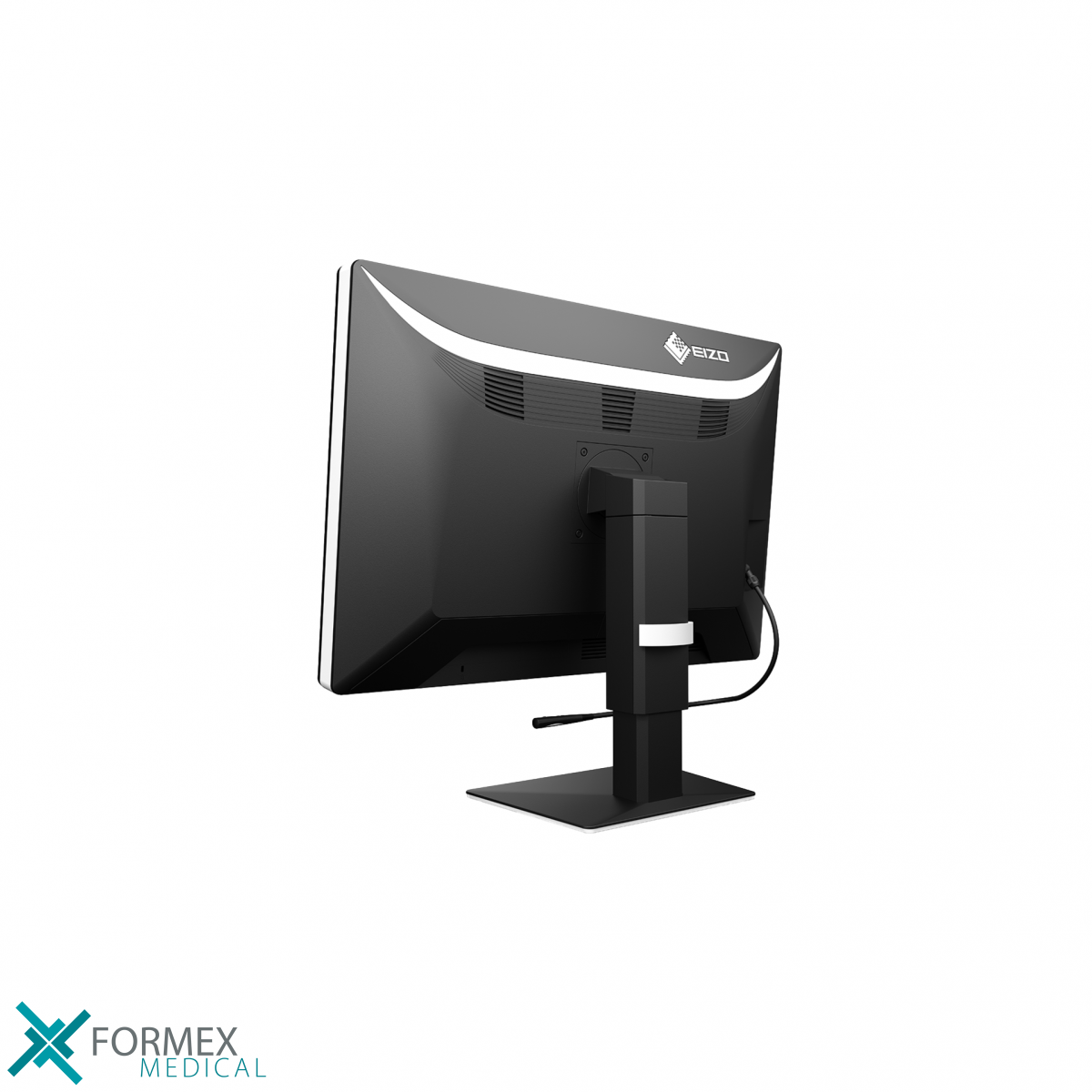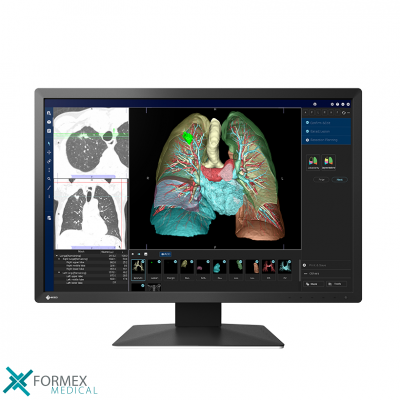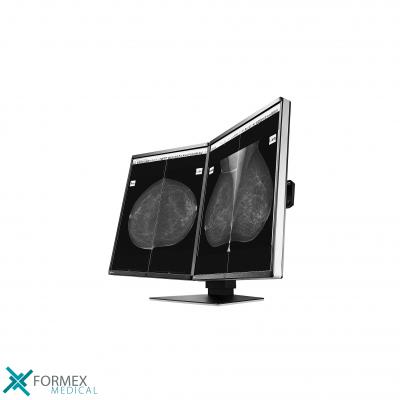Compact, versatile monitor with 12 megapixels for convenient diagnostics in radiology
With a resolution of 12 megapixels, the RX1270 is an effective alternative to the traditional dual-monitor set-ups found in many examination rooms. The ability to display all desired grading protocols allows the radiologist to work with maximum comfort when interpreting images. The monitor is universal for greyscale and colour images and, with its fine dot distance of 0.155 mm, can display radiological images in detail, for example for mammography and imaging of fine structures. With its 78.4 cm diagonal, the monitor displays various images simultaneously and clearly, thus helping to streamline and optimise the workflow of radiological examinations. The large monitor also takes up much less desk space than several separate monitors. The user also has to move his head less, which contributes to viewing comfort. The comfort light at the back of the monitor can be switched on separately and there is a reading light at the front to make use of the otherwise dark report room more ergonomic.
With its 12-megapixel display (4200 x 2800), you can arrange shots on the RX1270 according to various protocols. A comfort light is integrated on the back, which provides a soft light that does not glare and stays within the limits of the allowed ambient light.
Eizo RX1270 RadiForce Image Quality
Precision, brightness, contrast and sharpness - we continuously develop our monitor technology further, use only high-end materials and rely on careful factory calibration of each individual monitor. As a result, you can always count on excellent image reproduction.
Perform monochrome and color image diagnostics with just one monitor
The Hybrid Gamma PXL feature distinguishes between monochrome and color images. Automatic. Pixel by pixel. This creates a hybrid display on which each pixel is displayed with the optimal tone value. Thus, higher precision and reliability are achieved than with traditional, planar detection methods.
The RX1270 reproduces demanding monochrome images as reliably as color images from any examination method. In practice, this means a clear efficiency gain, since recordings from various imaging processes can be diagnosed with just one monitor. The RX1270 is particularly suitable for diagnostic workstations that call for a large monitor diagonal with high local resolution, such as in mammography or for ultra-high resolution CT scans.
Blur reduction
High-brightness LCD panels often render images blurrier than the original due to overexposure. EIZO therefore offers a blur reduction function integrated into the monitor. This function ensures that the details that have disappeared in the blurred edges are displayed again in maximum brightness on the monitor.
Sharp and high resolution images
The monitor has a pixel width of 0.1554 mm and therefore displays even, high-resolution and deep black images. Without any kind of graininess.
Consistent display using artificial intelligence
The color and brightness of an LCD monitor can change under the influence of the ambient temperature and the temperature of the monitor itself. RadiForce monitors for radiological diagnostics are equipped with a temperature sensor and intelligent algorithms for control. With this technology, the monitor adjusts its corrections in real time for reliable display of gradations, color, brightness and other image characteristics.
In addition, EIZO also uses artificial intelligence in the RX1270's algorithm, which distinguishes between changing patterns in temperature to calculate an even more accurate correction.
Consistent image quality thanks to integrated front sensor
Accurate calibration of white point and tonality curve is guaranteed thanks to a front sensor (IFS) integrated into the frame. It measures brightness and gray scales and independently calibrates the monitor according to the DICOM® standard. The sensor works automatically without restricting the monitor's field of vision. You spend less time on maintenance and can rely on consistently high image quality.
Reliable brightness
At EIZO, we are convinced of the quality of our products. That's why brightness stability is also covered by the warranty on the monitors.
Even illumination across the entire screen
The monitor impresses with its even illumination. This is ensured by the Digital Uniformity Equalizer (DUE), which automatically corrects irregularities pixel by pixel. Shades of gray from radiological and other medical images are reproduced correctly on the entire screen. This is indispensable for diagnosis.
Constant brightness during operation
A sensor for the backlight continuously determines the luminance of the monitor. The advantage: The set and calibrated values are already displayed accurately a few seconds after switching on and remain constant throughout the entire operating period. The sensor is invisibly integrated into the monitor.
A backlight sensor continuously determines the luminance of the monitor. The advantage: The set and calibrated values are precisely displayed just a few seconds after switching on and remain constant throughout the entire operating period. The sensor is integrated invisibly into the monitor.
- Compacte, veelzijdig inzetbare monitor met 12 megapixels voor comfortabele diagnostiek in de radiologie
- Duidelijk zichtbare microstructuren door hoog contrast en Sharpness Recovery
- Palet met 543 miljard kleurtinten voor precieze kleurweergave van maximaal 10 bits
- Hybrid Gamma PXL-functie voor tot op de pixel nauwkeurige weergave van grijstinten- en kleurenbeelden met de vereiste helderheidskarakteristieken
- Homogeen weergavegebied door automatische regeling van de helderheidsverdeling (DUE)
- Geschikt voor kalibratie, acceptatietesten en testen voor de constantheid conform DIN V 6868-157 en QS-RL
- Flexibele protocollen voor de rangschikking voor optimaal comfort tijdens de diagnostiek
- Efficiënte kwaliteitswaarborging en een geïntegreerde kalibratiesensor
- Comfortabele achtergrondverlichting en leeslamp voor de ideale verlichtingssterkte tijdens de diagnostiek


















-1966.png)
-1962.jpg)